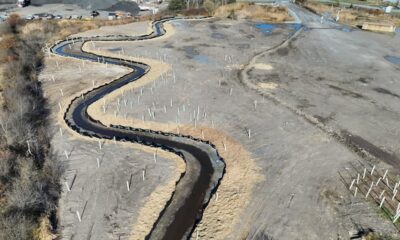Science
Deep River Archaeological Study Aims to Uncover Indigenous History

Researchers are delving into the history of an Indigenous village in Deep River, Canada, as part of an archaeological study aimed at uncovering artifacts that could reveal insights into the community before the establishment of the townsite. The project, spearheaded by Courtney Cameron of Cameron Heritage Consulting Limited, focuses on the area surrounding the Keys Conference Centre and is aligned with a broader initiative, “Finding Their Voices,” led by Steffanie Adams from George Brown College.
Uncovering Historical Artifacts
During her presentation to the town council last week, Cameron highlighted the discovery of various artifacts, including a surprising quantity of coal. “The only source of coal would’ve been from the train tracks, which would’ve been a good hike. Why is it there, and where did it come from?” she questioned, underlining the potential significance of these findings.
The artifacts primarily originated from the southern part of the property where the historic Brindle cabin once stood. “That’s where we got a lot of the pre-1944 stuff,” Cameron noted, mentioning several personal and domestic items, such as an old green glass bottle labeled “Dr. Pfunder’s Medicine for Upset Stomachs,” foundation stones with cement, ceramics, various metal objects, and a Catholic Rosary Cross made in France. “It must have meant something to somebody at some point,” Cameron reflected.
Given the findings, Cameron is advocating for a Stage 3 assessment to determine the cultural heritage significance of the Brindle property. “I’ve assessed it to the point where I recommend a Stage 3,” she stated, emphasizing the importance of understanding and possibly preserving the historical context of the site.
A Community’s Cultural Heritage
Cameron expressed her excitement about working on a site that extends beyond the typical period she usually explores. “Most of my work is done on sites leading up to 1900, whereas this one carries forward to 1945,” she explained. “We don’t really think of anything being culturally important after that. And I don’t know of any other archaeological sites in Ontario that have an Algonquin village. Not one. It’s amazing. It’s very rare to have that.”
The town council shared her enthusiasm. Councillor Terry Myers expressed excitement about the findings but lamented the delayed appreciation for the town’s historical context. “It’s a shame that it took us a very long time to start to develop an appreciation for the history of the village that was here before 1945,” he remarked.
Professor Adams, who is directly involved in the “Finding Their Voices” project, aims to utilize immersive technologies, such as augmented and virtual reality, to create a visual and audio tour of the settlement as it appeared prior to 1945. “The last two years have been about collecting as much information as we could,” she remarked. Adams’ team has also engaged with the Mackenzie Community School to explore building a community swing to commemorate the cabin of Joseph Adams/Lukus.
The swing, which hung from a tree outside the school for approximately 20 years before falling apart, serves as a tangible connection to the past. “It’s about trying to bring that history back,” Adams stated.
While Councillor Myers reflected on the town’s late recognition of Indigenous history, Reeve Glenn Doncaster highlighted the historical injustices faced by the Indigenous community. “The colonization of Renfrew County happened over time, but that’s not what happened in Deep River,” he explained. “What happened in Deep River was the government came in and expropriated the land, didn’t relocate anybody, and just told them to leave.”
Doncaster acknowledged the significance of the cabin still standing and inquired about its future. Adams responded that the fate of the cabin is a matter for her family, the descendants of David and Mary Adams, who built and lived in the cabin. “I would like to have it protected, and see it protected, for another 50 to 70 years,” she asserted, advocating for its status as a cultural symbol for the broader Algonquin community throughout the Ottawa Valley.
This archaeological study not only strives to uncover the past but also emphasizes the necessity of preserving cultural heritage, making it a significant undertaking for the community of Deep River.
-

 Politics4 weeks ago
Politics4 weeks agoSecwepemc First Nation Seeks Aboriginal Title Over Kamloops Area
-

 World5 months ago
World5 months agoScientists Unearth Ancient Antarctic Ice to Unlock Climate Secrets
-

 Entertainment5 months ago
Entertainment5 months agoTrump and McCormick to Announce $70 Billion Energy Investments
-

 Science5 months ago
Science5 months agoFour Astronauts Return to Earth After International Space Station Mission
-

 Lifestyle5 months ago
Lifestyle5 months agoTransLink Launches Food Truck Program to Boost Revenue in Vancouver
-

 Technology3 months ago
Technology3 months agoApple Notes Enhances Functionality with Markdown Support in macOS 26
-

 Lifestyle3 months ago
Lifestyle3 months agoManitoba’s Burger Champion Shines Again Amid Dining Innovations
-

 Top Stories2 months ago
Top Stories2 months agoUrgent Update: Fatal Crash on Highway 99 Claims Life of Pitt Meadows Man
-

 Politics4 months ago
Politics4 months agoUkrainian Tennis Star Elina Svitolina Faces Death Threats Online
-

 Sports5 months ago
Sports5 months agoSearch Underway for Missing Hunter Amid Hokkaido Bear Emergency
-

 Politics5 months ago
Politics5 months agoCarney Engages First Nations Leaders at Development Law Summit
-

 Technology5 months ago
Technology5 months agoFrosthaven Launches Early Access on July 31, 2025




















